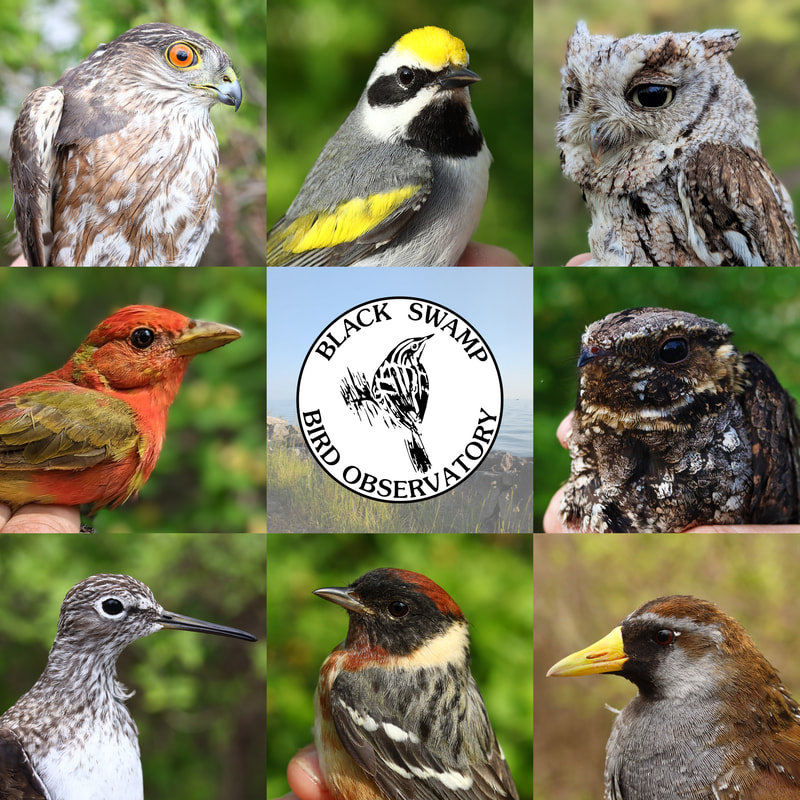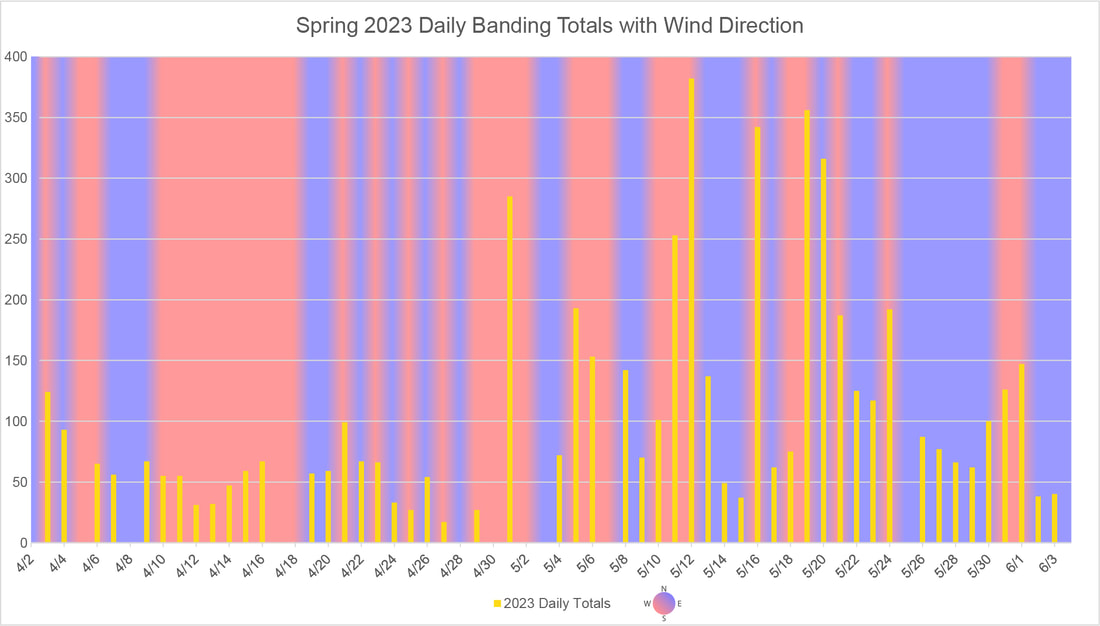Enjoying our blogs?Your support helps BSBO continue to develop and deliver educational content throughout the year.
|
|
With the spring migration banding season now behind us, we wanted to take a moment to reflect on some of the ups and downs of the past couple months. While every season is unique, overall, it was kind of an unusual season: cold weather and many nights of north and east winds weren't conducive to a normal spring. Our first push of birds, which usually happens at the end of April, was really more of a trickle. Instead of getting days with hundreds of White-throated Sparrows or hundreds of Ruby-crowned Kinglets, we ended up with them spaced out over a much longer period of time. Even Myrtle Warblers (which tend to be a major mover in early spring) had one day of ~180 birds banded, and then a sparse showing following this one push.
Without southwest winds to facilitate movement, birds took their opportunity to migrate whenever they could, rather than coming all at once. This lack of a tail wind combined with northerly winds also meant that birds were more distributed across the landscape, rather than being directed to our part of the lakeshore. But aside from the less-than-ideal wind direction, the season was also unusual in terms of species abundance. On the whole, most warblers were below the long-term average. However, some, such as Northern Parula and Black-throated Blue Warbler, were well above average. But most noticeable in absence were the thrushes. While Hermit Thrushes had a strong and protracted migration (being well above average), the other brown thrushes were all below average. Although Swainson's Thrush ended up not being too far off from average, their lack of presence was continually noted throughout the spring. Typically, we will capture the first Swainson's Thrush in early May, with the bulk of birds traveling through in mid- to late May. But, we didn't capture a Swainson's until May 11, with the busiest day for the species only having 37 birds banded. We actually banded all the other brown thrushes before having a Swainson's!
Aside from the sort of "slow" nature to this spring's migration, we did have some other interesting captures this year. While the station focuses on songbirds and near-songbirds, our nets will capture (but not always hold!) anything that flies. This included a Sora and Solitary Sandpiper this season, neither of which has been banded at the station in a number of years. We were also able to start operations early enough most mornings to capture an Eastern Whip-poor-will and two Eastern Screech-Owls (plus three return screech-owls).
Speaking of returns (birds banded in a previous season), we introduced a new piece of technology to our operations this season: a tablet loaded with the past eight years of banding data to make our recapture recording and age verifications much smoother. With this, we already know that, of our recaptured birds, about 125 were return birds. While most of these birds were from the fall of 2022, many were older with quite a few having been originally banded in 2021 and 2018 and even a couple from 2015. So, while migration may have felt a little "off" this spring, it was still an interesting season regardless. Our goal isn't to capture as many as birds as possible, but rather to document the passage of birds from year to year in a consistent method. Every year (and every individual species) is different; some are high, some are low, and some are average. But, even the slow years allow us to gain critical information that can be used to aid the conservation of those species that pass through this area every spring. While there is much work ahead now on data entry, presented here is a preliminary breakdown of some of the numbers from this season: Total Birds Banded: 5,647 Species Banded: 102 Banding Days: 52 Banding Hours: 268.62 Total Net Hours: 6090.26 Number of Volunteers: 43 Species with New High Records: Tree Swallow - 51 American Robin - 42 Yellow-shafted Flicker - 21 Top Ten Species Banded: Gray Catbird - 468 White-throated Sparrow - 461 Magnolia Warbler - 349 American Redstart - 328 Myrtle Warbler - 294 Ruby-crowned Kinglet - 237 Hermit Thrush - 211 Swainson's Thrush - 200 Yellow Warbler - 191 Common Yellowthroat - 179 For more numbers throughout the season, head over to the 2023 Spring Daily Banding Totals on our Passerine Research Page. We would like to thank our incredible, dedicated group of volunteers and seasonal techs that put all their effort into ensuring a successful banding operation, for both data quality and bird safety. We couldn't do it without all your support!!! We would also like to thank the amazing crew at Ottawa National Wildlife Refuge for their continued support of this project and Davis–Besse Nuclear Power Station and Energy Harbor for preserving and allowing access to this incredible habitat. If you would like to support BSBO's research efforts, please consider our Sponsor a Mist Net program, which directly contributes to our banding programs. Learn more and Sponsor a Mist Net here.
0 Comments
Your comment will be posted after it is approved.
Leave a Reply. |
AuthorsRyan Jacob, Ashli Gorbet, Mark Shieldcastle ABOUT THE
|

